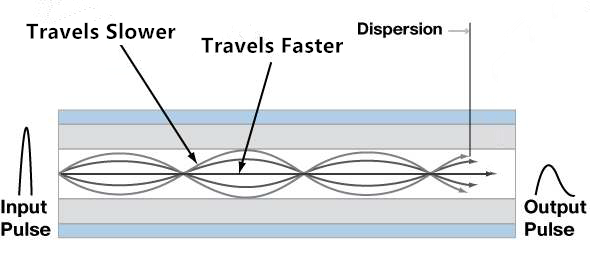What Affects the Optical Transmission Distance?
Optical network has now been more and more popular now, for it has several advantages, such as high speed, high bandwidth and high density. And fiber optic cables can support much longer distance than traditional copper cables (like twisted pair cables or coaxial cables). However, in practice, the distance that fiber optic cable can support is affected by many factors. Transmission distances of optical links vary from meters to hundreds of meters and kilometers, but optical signals may become weak over long distances. What affects the transmission distance? This article will talk about several factors that affect optical transmission distance.
Generally, the maximum transmission distance is limited by the dispersion in fiber optic cables. There are two types of dispersion that can affect the optical transmission distance—chromatic dispersion and modal dispersion. Chromatic dispersion is the spreading of signals over time resulting from different speeds of light rays. Modal dispersion represents the spreading of the signals over time resulting from different propagation modes.
For single-mode fiber optic cable transmission, it is chromatic dispersion that affects the transmission distance. The reason is that the core of a single-mode fiber optic cable is much smaller than that of a multimode optical cable, and only allows one mode of light to propagate. Single-mode optical cable can transmit signals over longer distance than multimode optical cable. Multimode optical cable transmission is largely affected by modal dispersion, because these optical signals cannot arrive simultaneously and there is a delay between the fastest and the slowest modes, which causes the dispersion and limits the performance of multimode fiber optic cables, as shown in the following picture.

Fiber optic cable is the path for the transmission of optical signals. However, most of the terminals are electronic based, so the conversions between electrical signals and optical signals are very necessary. And this process largely depends on fiber optic transceivers, which are commonly used in most of today's fiber optic networks. LED (light emitting diode) or laser diode inside are the light sources of fiber optic transceivers, which can also affect the transmission distance of a fiber optic link.
LED diode based transceivers can only support short distances and low data rate transmission. They cannot satisfy the increasing demand for higher data rates and longer transmission distances. For higher transmission data rates, laser diodes are used. Several commonly used laser sources in fiber optic transceivers are Fabry Perot (FP) laser, Distributed Feedback (DFB) laser and Vertical-Cavity Surface-Emitting (VCSEL) laser. For example, TRENDnet TEG-MGBSX SFP transceiver is a 1000BASE-SX SFP transceiver module with a VCSEL laser transmitter, which can support a data rate of 1.25Gbps and 550m transmission distance. The following table shows the main characteristics of these light sources.

Splices or connectors are inevitable in many fiber optic systems. Signal losses can be caused when optical signals pass through each splice or connector. The amount of the loss depends on the types, quality and number of connectors and splices. For example, signal loss through an LC LC multimode duplex fiber cable may not be the same with an ST ST multimode duplex fiber cable.
As mentioned in the above table, different laser sources support different frequencies. The maximum distance an optical system can support is also affected by the frequency at which the signals are transmitted. Generally the higher the frequency is, the longer distance the optical system can support. Thus, choosing the right frequency to transmit optical signals is quite necessary.
The bandwidth that fiber optic cable supports is another important factor that influences the transmission distance. As the bandwidth increases, the transmission distance usually decreases proportionally. For instance, a fiber that can support 100 MHz bandwidth at a distance of 5 kilometers will only be able to support 250 MHz at 2 kilometers and 500 MHz at 1 kilometer.
There are many factors that affect the optical transmission distance, such as the type of fiber optic cable, light source of fiber optic transceiver, splices and connectors, frequency of transmission, bandwidth that the network supports. All these factors need to be taken into consideration during the deployment of fiber optic networks to minimize the limitations on the transmission distance.